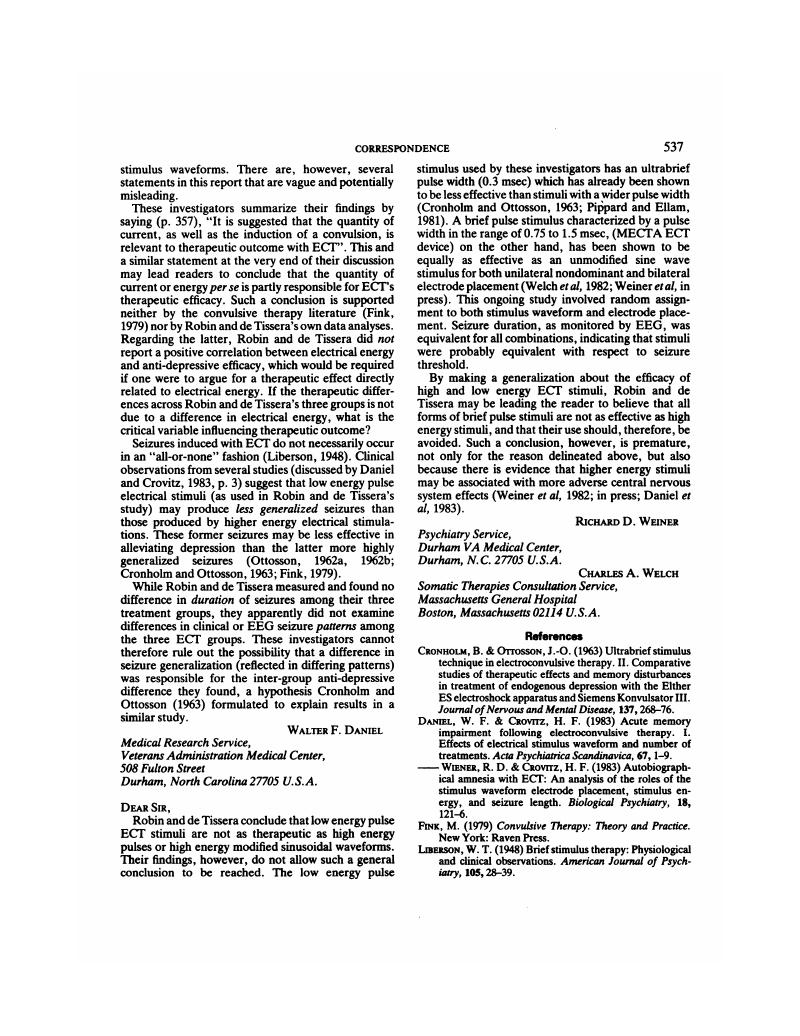No CrossRef data available.
Article contents
[No Title]
Published online by Cambridge University Press: 29 January 2018
Abstract
An abstract is not available for this content so a preview has been provided. As you have access to this content, a full PDF is available via the ‘Save PDF’ action button.

- Type
- Correspondence
- Information
- Copyright
- Copyright © 1983 The Royal College of Psychiatrists
References
Cronholm, B. & Ottosson, J.-O. (1963) Ultrabrief stimulus technique in electroconvulsive therapy. II. Comparative studies of therapeutic effects and memory disturbances in treatment of endogenous depression with the Either ES electroshock apparatus and Siemens Konvulsator III. Journal of Nervous and Mental Disease, 13
7, 268–76.Google Scholar
Daniel, W. F. & Crovitz, H. F. (1983) Acute memory impairment following electroconvulsive therapy. I. Effects of electrical stimulus waveform and number of treatments. Acta Psychiatrica Scandinavica, 67, 1–9.Google Scholar
Daniel, W. F., Wiener, R. D. & Crovitz, H. F. (1983) Autobiographical amnesia with ECT: An analysis of the roles of the stimulus waveform electrode placement, stimulus energy, and seizure length. Biological Psychiatry, 18, 121–6.Google Scholar
Liberson, W. T. (1948) Brief stimulus therapy: Physiological and clinical observations. American Journal of Psychiatry, 105, 28–39.CrossRefGoogle Scholar
Ottosson, J-O (1962a) Electroconvulsive therapy—Electrostimulatory or convulsive therapy?
Journal of Neuropsychiatry, 3, 216–20.Google Scholar
Ottosson, J-O (1962b) Seizure characteristics and therapeutic efficiency in electroconvulsive therapy: An analysis of the antidepressive efficiency of grand mal and lidocaine$modified seizures. Journal of Nervous and Mental Disease, 135, 239–51.Google Scholar
Pippard, J. & Ellam, L. (1981)
Electroconvulsive Treatment in Great Britain, 1980.
Gaskell (The Royal College of Psychiatrists). Ashford, Kent: Headley Brothers.Google Scholar
Weiner, R. D., Rogers, H. J., Davidson, J. & Miller, R. D. (1982) Evaluation of the central nervous system risks of ECT. Psychopharmacology Bulletin, 18, 29–31.Google Scholar
Weiner, R. D., Rogers, H. J., Welch, C. A., Davidson, J. R. T., Miller, R. D., Weir, D., Cahill, J. F. & Squire, L. R. (1983) ECT stimulus parameters and electrode placement: Relevance to therapeutic and adverse mechanisms. In ECT: Basic Mechanisms (eds. Lerer, B., Weiner, R. D., and Belmaker, R. H.). London: John Libbey. In press.Google Scholar
Welch, C. A., Weiner, R. D., Weir, D., Cahill, J. F., Rogers, H. J., Davidson, J., Miller, R. D. & Mandel, M. R. (1982) Efficacy of ECT in the treatment of depression: Waveform and electrode placement considerations. Psychopharmacology Bulletin, 18, 31–4.Google Scholar



eLetters
No eLetters have been published for this article.